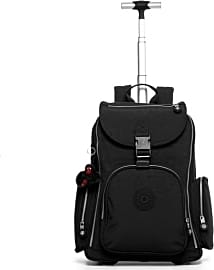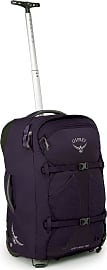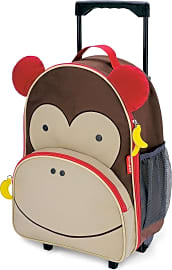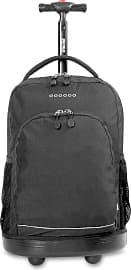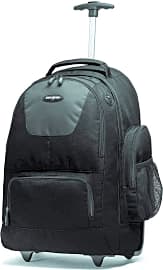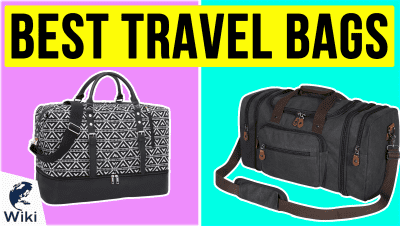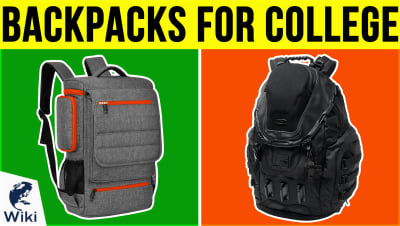The 10 Best Rolling Backpacks

This wiki has been updated 44 times since it was first published in March of 2015. Give your back a break and grab one of these extremely handy wheeled backpacks. Ideal for students carrying laptops and heavy books, or travelers wanting to avoid checking luggage, these rolling models offer plenty of convenience and functionality. We've included both professional looking choices, as well as some that boast more whimsical designs, including a couple geared toward kids. When users buy our independently chosen editorial selections, we may earn commissions to help fund the Wiki.
Editor's Notes
November 20, 2020:
At this time, we've kept a range of rolling backpacks that will suit everyone from office workers to school children. Because we're concerned about overall long-term durability, we've removed both the Olympia Melody and the Tilami School and Travel. Taking their spots are the Deuter Helion 60 and the K-Cliffs See Through. The Deuter model, from a well-respected luggage maker, is quite big and heavy, so you'll want to consider it as a travel bag, rather than as a business or college backpack. The K-Cliffs See Through lives up to its name by being entirely clear. Such a construction isn't ideal for all situations, but if your school or office requires that you use a transparent bag for safety reasons, this will help you meet that requirement.
As for top choices, the Matein Freewheel and the JanSport Driver 8 still make the cut, but we've replaced the High Sierra XBT with the High Sierra Chaser. The Chaser's styling is less bulky and clunky, and it has a water bottle pocket, a feature not found on the XBT. This pocket isn't terribly large, however, so don't expect it to hold your monster Hydro Flask.
For kids, the Skip Hop Zoo and the J World New York Sunny remain good options, especially since they come in fun, eye-catching designs. Unfortunately, the Skip Hop model no longer comes with a parent strap, which might be a dealbreaker for some. A parent strap allows you to carry the bag easily should your little one become tired of rolling the bag; without one, you may find it slightly cumbersome to carry.
December 12, 2019:
When most people think of backpacks, a few popular names come to mind, and you'll find options from plenty of these makers here. These include the JanSport Driver 8 Core Series, which is rugged and offered in plenty of colors (but doesn't have the best shoulder straps of the entire bunch). We removed the JanSport Superbreak, however, as it has become difficult to find most color options. There's also the Osprey Fairview 36; it comes in versions for both men and women, and it makes a fine travel companion — it might be overkill for the office, though.
If you do need a business backpack, the Samsonite 17896 or High Sierra XBT are ones to consider. The latter doesn't have a sturdy water bottle pocket, however, which can be a nuisance to those who like to stay hydrated. There's also the Matein Freewheel, a new addition that earns its place thanks to its budget-friendly price. And with its relatively plain styling, it is fine for just about all uses, from hauling textbooks to visiting clients.
Special Honors
L.L.Bean Deluxe Pack Some may balk at the cost, especially since it is made for kids who probably won't be gentle with it, but the L.L.Bean Deluxe Pack is a good value nevertheless. Thanks to the in-line skate wheels, it rolls smoothly, and the T-handle has a comfy, ergonomic grip that makes it a breeze to pull. llbean.com
Tumi Merge You can worry less about your impact on the environment when you choose the Tumi Merge, which is made with both post-industrial recycled nylon and post-consumer recycled bottles. Despite these reused materials, it has a modern, sleek appearance, complete with a 15-inch laptop compartment, and it can be monogrammed with the recipient's initials. tumi.com
History Of The School Backpack
It wasn't long before nylon became the new standard for backpack material.
The original backpacks, also referred to as rucksacks, were created for outdoor applications like hiking and cross country skiing. The first resemblance to today's modern day backpack was created in 1938, by avid outdoorsman and 10th Mountain Division veteran, Gerry Cunningham. To make them more accessible during rock climbing, he incorporated zippers, including two zippered compartments near the top of the pack, a revolutionary idea in comparison to the single-compartment drawstring predecessor. Cunningham's creation made it safe for climbers to access their materials without having to remove the pack off their backs. These zippered packs were quickly manufactured and available for purchase shortly after.
Nearly 30 years later, in 1967, Cunningham made another revolutionary adjustment to the rucksack. He started to manufacture them out of nylon, instead of the commonly used canvas, to make them more durable and lighter in weight. It wasn't long before nylon became the new standard for backpack material. This was a popular time for outdoorsy sports and a number of new companies started popping and manufacturing outdoor gear, such as Kelty, The North Face, Patagonia, and Jansport.
Jansport started in Seattle, and one of their very first products was the Ski and Hike daypack, which were being sold in the typical outdoors stores, one of which happened to be connected to the University of Washington bookstore. Probably because of the large amount of rain the Seattle area receives, many students started buying the Jansport daypack to carry their books. Other west coast school book stores followed suit and started selling the Jansport pack to students, popularizing them forever. Despite the high sales, Jansport didn't focus on the student market and continued to concentrate on the outdoors industry.
In 1974, another outdoor gear company was founded in Chico, California, Caribou Mountaineering. One of the founders, Gary Kirk, was attending classes at Chico State at the time and was having trouble finding a backpack that could contain all of his books. Together with seamstress Marcia Briggs, they created a backpack called the Cricket, which was shaped according to the size of his textbooks. It also sold well at school bookstores and in 1985, Kirk approached L.L. Bean executive Ned Kitchel who put it in their catalog. In no time it became the company's top-selling product and school backpack was born.
The Evolution Of Wheeled Luggage
To understand the history of the wheeled backpack, one must first look to the invention of wheeled luggage, as it is just an offshoot of the product. Until the late 1980s, all luggage was oriented horizontally and were made from some kind of bulky and inflexible material. They had to be manually carried through airports and train stations, and were anything but user-friendly. There were a few models that included four wheels on the bottom and were towed behind by a small strap, but these were also inconvenient as they would often roll into the user's heels, tip over on turns, or get caught up on obstacles.
They had to be manually carried through airports and train stations, and were anything but user-friendly.
In 1987, Bob Plath, a Northwest Airlines pilot, designed a bag with a vertical orientation, an extendable handle, and two wheels. It could easily be rolled through airports and carried when inside an airplane. He named his invention the Rollaboard and sold them to other pilots and flight attendants. It didn't take long for frustrated consumers to see the appeal of the Rollaboard and, by 1989, they were constantly asking airline employees where they too could buy one.
The popularity of the Rollaboard allowed Plath to retire from Northwest by 1991, at which time he moved into a 185,000 square foot warehouse and started full time production. Not only did Plath revolutionize how people carried luggage with the invention of the Rollaboard, he also revolutionized airplane overhead bin configuration. Because of the number of people using the new style of wheeled luggage, airlines were forced to redesign the overhead storage bins on their fleets to carry them.
Backpacks And Back Pain
Back pain is no longer just a problem for the middle-aged and the elderly. As textbooks get heavier and carrying a laptop or tablet to school is becoming the norm, more students are affected by mid and lower back pain every year. It is even being seen in students as young as eight years old.
Even well distributed loads can cause problems if they are too heavy.
In 2013, there were nearly 22,000 injuries caused by heavy backpack loads treated in doctor's offices and hospitals, including fractures, dislocations, strains, and sprains. Many of these injuries can cause back pain that extends into adulthood.
Carrying heavy backpacks frequently can damage the soft shoulder tissues, which can lead to microstructural nerve damage. These types of of injuries can eventually inhibit movement of the hand and fingers. Heavy loads that are unevenly distributed, like when a child carries their backpack over one shoulder, will cause the muscles to compensate by leaning to the opposite side. This causes strain and muscle imbalance on the side not carrying a load which speeds the development of back problems in adulthood and can cause pain in the short term.
Even well distributed loads can cause problems if they are too heavy. When overloaded, a backpack may distort the back's natural curves and lead to a rounding of the shoulders. Most will also lean too far forward when there is a heavy load on their back, causing them to become imbalanced and fall easily if they stumble.


